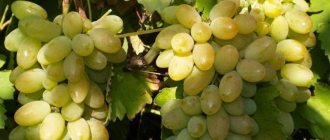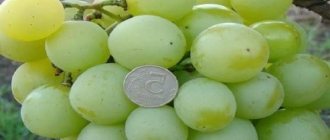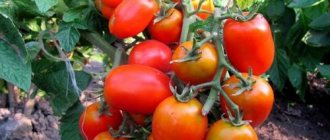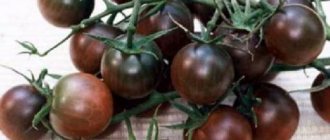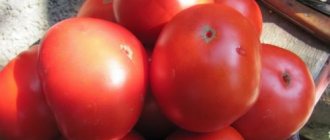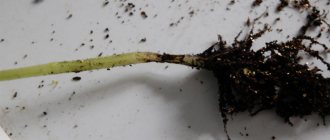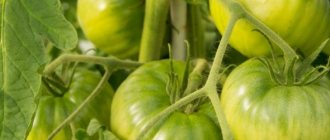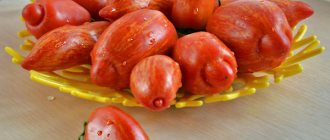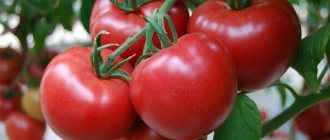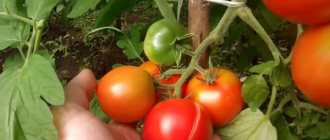Characteristics and description
Hybrid Nasha Masha is a mid-early, high-yielding crop recommended for growing in greenhouses. Subject to proper agricultural practices, vegetables can also be grown in open ground.
Distinctive features
Characteristic features of the hybrid:
- bush height - 1.6-1.7 m;
- stems are dense and strong;
- medium sized leaves;
- shoot growth is unlimited;
- the first inflorescence is formed above the 10th leaf;
- In total, 7-8 fruiting clusters are laid on the bush, one every 3 leaves;
- the bunch consists of 5-6 fruits;
- weight of one fruit - up to 180 g;
- 100–104 days pass from seed germination to fruit ripening.
The hybrid is resistant to fusarium, tobacco mosaic virus, cladosporiosis, and tolerates extreme conditions, stress, temperature changes and lack of light.
Fruit characteristics
The crop is high-yielding: up to 10 kg of tomatoes are harvested from 1 m2 of land under optimal cultivation conditions.
The fruits have:
- bright red color;
- round or slightly square shape;
- smooth texture;
- thick skin;
- pronounced tomato taste.
At the breaking point, the tomatoes are sugary; in taste, sweetness prevails over sourness. The weight of one fruit is up to 200 g.
Growing tomato Countryman
The Countryman tomato is usually grown through seedlings, but in warm climates it is possible to plant the seeds directly in open ground.
Rules for planting tomato seedlings Zemlyak
Since the ripening period for this tomato is approximately 3 months, vegetable growers in the southern regions of Russia do not grow Zemlyak seedlings
, and immediately plant the seed in the last ten days of April - the first ten days of May in the beds. And already in the last ten days of July, the harvest of ripe fruits is harvested.
In other Russian regions it is necessary to grow this tomato in seedlings.
. In this case, seed material is planted in the last ten days of March. Since about 60 days should pass from the moment of seed germination to the planting of Zemlyak tomato seedlings in open ground, the specific sowing period is calculated based on the climatic conditions of the growing region - by the time of transplanting to garden beds there should be no return spring frosts.
Tomato variety Countryman in open ground - video
Soil for planting seedlings is bought in a specialized store, and seeds collected from your beds should be disinfected in Bordeaux mixture before planting and then germinate. And only then sow.
Seed material is planted in wide, low containers. At the stage of a pair of permanent leaves, the plants are picked, transplanted into a separate container.
One of the advantages of the Zemlyak tomato variety is that the grown seedlings are not prone to overgrowth. However, even before transplanting the seedlings to a permanent place, buds may appear on them, which may fall off during transplantation and further acclimatization of the plants. Therefore, it is advisable to plant seedlings before flowers appear on them.
Important!
7-10 days before transplanting, the seedlings of this tomato must be hardened off: on a balcony, loggia or outside on a warm day.
Planting seedlings in a permanent place
Seedlings are planted in beds prepared in advance. The main thing is that the soil in them is well fertilized.
5-6 tomato bushes are planted on each square.
The plants are strong and not too tall, so some vegetable growers do not tie up the shoots. However, under the weight of ripening fruits, the stems may fall to the ground. Either you have to lay a thick layer of straw under the bushes so that the tomatoes do not come into contact with the soil, or put supports to which you tie the shoots in several places.
How to plant seedlings
The hybrid Nasha Masha is grown in seedlings, which allows young bushes to form a powerful root system and speed up harvesting. Seeds are planted 60–65 days before the intended planting in the ground.
Average sowing time:
- for the southern regions of Russia - the end of February - the first half of March;
- for the central ones - the second half of March;
- for the northern ones - early April.
Seed preparation
The seed material is pre-soaked in a growth stimulant so that the seedlings appear quickly and the germination percentage is high. Use “Zircon”, “Epin-Extra”, “Ecogel”, following the instructions on the package.
The manufacturer processes the hybrid seeds himself, but for additional disinfection, the seed is kept in a solution of potassium permanganate (30 minutes), then dried in the sun.
Attention! Seeds collected independently are not suitable: the second generation of hybrid tomatoes differs from the first in characteristics. Growers obtain seed by crossing parent varieties.
Soil and container
For sowing you will need:
- shallow plastic containers or boxes (7–10 cm) with drainage holes in the bottom;
- transparent film or glass according to the size of the containers;
- soil disinfected with potassium permanganate or high temperature.
For seedlings, purchase a universal soil mixture or prepare the substrate yourself from peat, river sand and turf soil in equal proportions.
Sowing
Sowing of tomatoes is carried out according to the following scheme:
- The container is filled with soil and lightly compacted.
- Make grooves 2 cm deep at a distance of 3-4 cm from each other.
- Seeds are placed one at a time at the bottom of the grooves, every 1-2 cm.
- Fill the grooves with soil and water with a small amount of water.
- Cover the container with film or glass that allows sunlight to pass through.
Seeds are germinated at a temperature of +25…+30 °C. The containers are placed near the battery or radiator while maintaining high humidity under the film and sealing the container tightly.
The first shoots appear 3–5 days after sowing. If the temperature is below +20 °C, the time period increases.
Seedling care
As soon as the first shoots appear, the film is removed and the container is placed in a well-lit place. For seedlings to be strong, the daylight hours should be 16 hours. Additionally, phytolamps are used.
In the early stages, water the seedlings carefully, at the root, using a pipette or syringe. The top layer of soil should remain moist. Only warm, settled water is suitable.
Important! If the temperature in the room drops at night, it is better to postpone watering to the morning so that the fungus does not multiply in the soil.
With the appearance of the first pair of true leaves, the seedlings are planted in separate containers, preferably directly into peat pots. This will make it possible in the future not to injure the root system when transplanting to a permanent place. It is important to dive as early as possible, while the seedlings are taking root well.
Tomatoes have a developed root system, so individual pots for seedlings should be at least 0.5–1 liter in volume.
Features of cultivation
Tomato Mashenka is suitable for the Central and Central Black Earth, North Caucasus regions, as well as the Urals, Volga region, Western and Eastern Siberia.
To obtain seedlings, it is recommended to sow seeds in March, the deadline is early April. Before planting in a permanent place, the seedlings are fed 2 or 3 times with a special complex for seedlings.
It can be transplanted into open ground in the third ten days of May or the first ten days of June. Planting should be done according to the 65x45 cm pattern.
Important! It is better to form a bush into one shoot, cutting off all the stepsons. It must be tied to a vertical or horizontal support so that the stem does not break under the weight of the fruit. Watering and fertilizing are carried out according to the standard scheme
When 4–6 bunches of fruit form on the shoot, the top needs to be pinched to stop further growth.
Watering and fertilizing are carried out according to the standard scheme. When 4–6 bunches of fruit form on the shoot, the top needs to be pinched to stop further growth.
Read useful articles about fertilizers for tomatoes:
- Organic, mineral, phosphorus, complex and ready-made fertilizers for seedlings and the TOP best.
- Yeast, iodine, ammonia, hydrogen peroxide, ash, boric acid.
- What is foliar feeding and when picking, how to carry it out.
How to grow tomatoes
When seedlings are planted in beds or in a greenhouse, the next stage of crop cultivation begins, associated with flowering and fruiting. During this period, more attention is paid to the above-ground parts of plants.
Landing rules
Bushes that have formed 3-4 pairs of true leaves and one flower cluster are planted in a permanent place. No more than 4 plants are placed on a plot of 1 m2, the depth of the holes is 30 cm.
Before picking, fertilizers are applied to each bush:
- a handful of humus;
- 1 tbsp. l. wood ash;
- 10 g superphosphate;
- 5 g potassium sulfate.
For your information ! It is good to plant tomatoes in beds where legumes, zucchini, cucumbers, cabbage, parsley or dill grew last season.
After planting, the ground around each bush is carefully mulched. It is better to use straw or sawdust, but other natural materials will also work.
Care during the growing season and fruiting
Tomatoes are watered at the root with settled warm water in the afternoon, when the soil is well warmed up. The soil around the bushes should remain loose, permeable to air and free of weeds.
During the flowering period, tomatoes are fed twice a month with complex mineral fertilizers: Floromix, Ecolist, Basfoliar. Every 10 days, the bushes are pruned: the side shoots are cut off, leaving petioles 1-2 cm long.
The bushes of the hybrid Nasha Masha are formed into 2 stems. They are tied to a support, and supports are installed under heavy fruit clusters.
Features of cultivation and possible difficulties
Thanks to its powerful root system, the Nasha Masha tomato is able to remain without moisture for a long period. When the fruits have already set, rare but abundant moisture is preferable.
The hybrid has heavily leafy shoots with numerous leaves and shoots. If the lateral shoots become more than 10 cm, the yield drops by 40–60%.
Diseases and pests
The culture is resistant to fusarium, cladosporiosis and tobacco mosaic virus. To prevent late blight, bushes are regularly sprayed with Ridomil Gold, Fitosporin, and Bordeaux mixture.
The most dangerous insect pests are:
- fall armyworm;
- Colorado beetle;
- aphid.
To combat them, insecticides “Fitoverm”, “Confidor”, “Aktofit” and others are used.
Important! During the period of fruit ripening, chemicals cannot be used: they are absorbed by plant tissues and enter the human body through the fruits. Use biological drugs or folk remedies.
Advantages and disadvantages of a hybrid
Advantages of the Nasha Masha f1 tomato:
- immunity to diseases characteristic of nightshades;
- rapid fruit ripening;
- long shelf life;
- good transportability;
- high productivity;
- resistance to extreme conditions.
Disadvantages of a hybrid:
- needs a garter and numerous supports;
- forms many stepchildren;
- The taste is inferior to other varieties of culture.
Farmer reviews
Olga, Moscow: “The hybrid is resistant to cladosporiosis. I liked that the bush is strong. The fruits are juicy and salad, the harvest is plentiful. However, the taste is inferior to other varieties.”
Alexey, Malakhovka village: “Until the first of August, the bush grew 2.2 m high, each harvested about 4 kg. Fruit weight is 100 g on average. If you rate the taste on a five-point scale, it’s a four.”
Tatyana, Pskov: “Our Masha is a productive and small crop, just right to roll into jars. She remained healthy until the coldest weather and did not get sick with cladosporiosis.”
History of growing the tomato variety Mashenka
Tomato Mashenka is not registered in the State Register of the Russian Federation. However, this does not mean anything: oddly enough, many varieties of various vegetable and fruit crops were not recorded in an official document. Among them there are varieties that are nothing special, as well as unique ones that are loved by gardeners.
It is also difficult to accurately determine the origin of the Mashenka tomato. Some consider it a variety of amateur selection, according to data), it was created in Altai, but there is no information about it. At the same time, it is known that about 8 years ago this mid-early variety was recognized by the gardening community as one of the best.
The Mashenka tomato is suitable for growing both in a greenhouse and outside it. In the southern regions and even in the center of Russia, they try to plant it in open ground, in colder regions - in protected ground. Designed for small farms and personal gardens.
